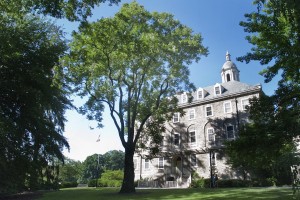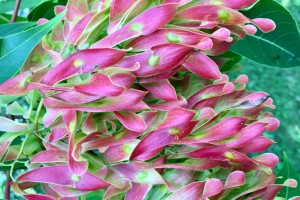From an Article by Kara Holsopple, The Allegheny Front, August 11, 2017
There’s an invasive tree that is becoming a threat to Pennsylvania’s forests. And it’s one that you see all the time. Ailanthus altissima, better known as tree of heaven, is a tough urban tree that sprouts out of sidewalks. It also happens to be the tree from the book A Tree Grows in Brooklyn. The tree came to the U.S. from China by way of England in the 1700s. And since then, it has thrived. The tree of heaven is found in 40 states, including most of Pennsylvania.
Matt Kasson is an assistant professor of forest pathology at West Virginia University. He’s been studying the tree for more than a decade, and his latest research was recently published in the journal Forests. The study was co-authored by Kristen Wickert, Eric O’Neal and Dr. Don Davis.
Kara Holsopple spoke to him about what he and his team have learned about the tree’s spread.
Kara Holsopple: Your newest research clues us into why this non-native tree has done really well. What did you find?
Matt Kasson: We’ve known for a while now that Ailanthus is pretty aggressive in colonizing the landscape. But what was unclear to us, and really the motivation behind the study, was to figure out its reproductive potential. If you drive down the highways right now you could see these brilliant red to orange colored seed clusters, prolific seed production on individual trees. But we wondered how much seed could these trees actually produce in a single year and over a lifetime.
KH: And what did you find?
MK: We found that there are some exceptionally reproductively capable individuals across the landscape. We found one tree in particular on the campus of Penn State University that routinely puts out about 700,000 seeds a year, and that’s been doing so for almost a century. So the cumulative seed production of that tree is somewhere north of 50 million seeds over its lifetime. Now that’s an exceptional tree. But we found that on average a tree that lived 40 years and was reproductively capable during that window could produce upwards of 10 million seeds.
LISTEN: “Tree of Heaven Creates Hell for Native Forests”
KH: Your study mentions viability. That’s the success of the seed once it gets into the ground if it’s going to become a tree or or not?
MK: I think viability is a really important aspect because if a tree can produce a million seeds per year, and viability is 3 percent, that’s not a lot of reproductive capacity. But if viability is north of 70 percent like we found on a few of our individuals including this 104 year old individual in Pennsylvania, the potential for producing a lot of progeny over a lifetime is exceptional.
KH: So why is this tree’s kind of super reproductive power and it’s spread a problem?
MK: It wasn’t always a problem. And I think the ways we manage land and landscapes have changed over time. Following another invasive pest, the gypsy moth, we saw widespread land clearing which really set up these forests for Ailanthus. Gypsy moth has been here since the 1800s and it started to devastate forest in Pennsylvania and throughout the Appalachian region in the late 70s to early 80s. We saw widespread salvage harvesting in the aftermath of this gypsy moth defoliation because the defoliation was so severe that it actually killed a lot of the oak trees that were occupying these ridge tops in South Central Pennsylvania and elsewhere throughout the mid-Atlantic. So one reproductively capable female tree at the edge of this clear cut seeded in the hole clear cut. And now you’re left, not with native trees regenerating, but a whole entire stand of invasive trees.
KH: Is this something that’s worrying for foresters?
MK: Absolutely. Tree of heaven, not only can outcompete native species that might seed into those same clearings, but it also produces compounds that inhibit the germination of native plants. It’s called allelopathic and what it does is it produces these compounds that make the site more suitable for itself to regenerate and less suitable for native plants. If we think about the spotted lanternfly which is a new pest that’s just been found in Pennsylvania, it actually requires Tree of Heaven to fulfill its lifecycle: It feeds on the foliage, it lays eggs on the stems, and it’s a real threat to the grape industry. Tree of heaven is pretty well established throughout most of the counties in Pennsylvania with the exception of a few of the northern tier counties. So, in that sense, it could follow tree of heaven up towards Erie and up to New York into the Finger Lakes region where it could directly threaten and impact the grape and wine industries in those regions.
KH: How can you get rid of them? Can you cut them down? What are some of the ways that you can remove them?
MK: I’ve been working on biological control using native fungi to kill Tree of Heaven in these forest settings for about a decade now. But there’s still plenty of stands of Atlantis that haven’t been controlled. And until they’re removed, whether it be through biological control or chemical applications or mechanical removal, they’re going to continue to be under-productive forests that supplant native species and prevent future generations of native forested stands from establishing.
KH: Tree of Heaven is commonly thought of as an urban tree. How did they move into the forest?
MK: That’s a good question. For a long time it just kind of hung out in Philadelphia and New York is kind of a botanical oddity passed around among early botanists and then seed producing trees were established and soon seedlings were available through a lot of the nursery trade and followed the railroad corridors east and west. We noticed a huge spike in the spread of tree of heaven in Pennsylvania following the completion of the Horseshoe Curve which connected the east and western part of the state.
Tree of heaven moved along those transportation corridors much like they move along our interstate highways now. But as to how they got in the forest, with building of roads and things like that, we see movement of invasive species whether it be through gravel or just that there’s a lot of exposed soil which allows prolific seed producing species to establish.
There was a recent study done out of Penn State that showed that these Marcellus shale well sites are now being taken over by a number of invasive plant species. We predict that tree of heaven will follow suit because it does occur up in those northern tier counties but they’re not really widespread as of yet. But with all this new road building and road construction to support the gas industry, I think we’ll see a lot more spread of these invasive species that are common throughout the the southern part of the state.
>>> Matt Kasson is an assistant professor of forest pathology at West Virginia University.



{ 1 comment… read it below or add one }
Tree of Heaven (Ailanthus altissima)
Scientific name: Ailanthus altissima
Kingdom: Plantae – Plants
Division: Magnoliophyta – Flowering plants
Class: Magnoliopsida – Dicotyledons
Family:Simaroubaceae – Quassia family
Genus: Ailanthus Desf – ailanthus
Life Cycle: Perennial
Description:
Tree of heaven is an exotic, rapidly growing, deciduous tree that emits an offensive odor. The leaves are compound, one to four feet long, and can have 11 to 25 alternating leaflets along the stem. Each leaflet will have at least one glandular tooth along the base. The leaves look similar to those of black walnut and sumac. The bark along the stems is typically smooth and pale gray and along the twigs is light chestnut brown. The tree is adioecious (male or female) and blooms in late spring creating small flowers ranging in color from green to orange. The fruit produced, called samaras, is flat, papery and twisted. Tree of heaven is propagated through the seeds or root sprouts. It is a fast growing tree that can reach 80 feet in height.(NPS, VA DCR)
Habitat:
Tree of heaven occurs in 42 states ranging from Maine south to Florida and west to California. It is most often seen in disturbed areas. It is distributed throughout the park and was found to be the most common exotic tree within the surveyed areas. (Hughes, NPS)
Common names:
Common names include Tree of heaven, China-sumac, Chinese tree of heaven, stinktree, and varnishtree (USDA ARS)
Other Facts:
Tree of heaven was introduced in America around 1748 by a Pennsylvania gardener and during the gold rush years in California by Chinese immigrants. It was being sold commercially by 1840. The wood is soft, weak and coarse-grained and can be harvested for timber. (NPS, USDA Plant Database)
Within Shenandoah National Park, tree of heaven is a targeted exotic plant because of its ability to rapidly grow and spread and also because it is known to produce a toxin in its leaves and bark that can inhibit the growth of other plants. It is important to the park to kill the invasive exotic species such as tree of heaven because invasive exotic species are known to be a significant threat to biodiversity. Only habitat loss is a greater threat. As an invasive exotic plant, the National Park Service attempts to remove tree of heaven from its lands. Removal is a difficult task requiring extreme diligence. Current techniques for removal include treatment with herbicides and manual removal of small trees. (Hughes, NPS, VA DCR)
References and Links:
Hughes, Jacob.2005. Draft ShenandoahNational Park Exotic Plant Surveys 1997-2004 Summary Report. Shenandoah National Park, Department of Natural and Cultural Resources, Luray, Virginia.
National Park Service (NPS). nd. Plant Invaders of Mid-Atlantic Natural Areas: Tree of Heaven. National Park Service.
Virginia Department of Conservation and Recreation (VA DCR). nd. Invasive Alien Plant Species of Virginia: Tree of Heaven Virginia Department of Conservation and Recreation, Richmond, Virginia.
Further information can be found:
Integrated Taxonomic Information System (ITIS) Report U.S. Department of Agriculture.
Germplasm Resource Information Network database which is sponsored by the Agricultural Research Service, U.S. Department of Agriculture.
PLANTS National Database, a website supported by the Natural Resource Conservation Service.